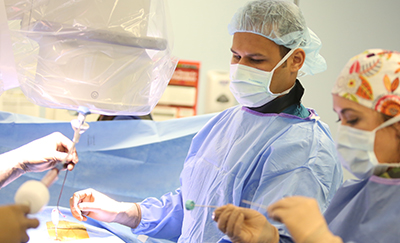 What is Minimally Invasive Surgery?
What is Minimally Invasive Surgery?
About Minimally Invasive Surgery | Information on MIS Equipment | Benefits | MIS Commonly Asked Questions
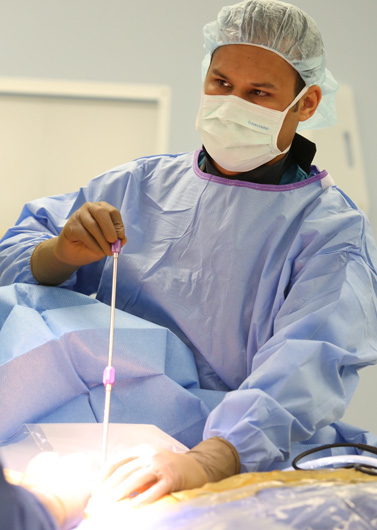
Minimally Invasive Surgery
Traditional “open” spine surgery may require several days in the hospital as it may involve a three-inch long incision, in which muscles and tissues are separated for optimal access to the injury site. The surgery usually results in trauma to surrounding tissues and some blood loss. Because of this the affected tissues and muscles need adequate healing time.
Spine surgery then home, same day
Spine Group Orlando uses the latest minimally invasive techniques and instrumentation to help patients recover in a shorter period of time and allow for a quicker return home.
Innovative developments in minimally invasive techniques have pioneered better ways for the surgeon to access the spine, moreover making the recovery process more seamless. In minimally invasive spine surgery, a smaller incision is made, sometimes only a half-inch in length. The surgeon inserts special surgical instruments through these tiny incisions to access the damaged disc in the spine.
Entry and repair to the damaged disc or vertebrae is achieved without harming nearby muscles and tissues when using minimally invasive techniques.
Minimally invasive spine surgery requires extensive training and experience to master use of the tools, but there is tremendous benefit for the patient.
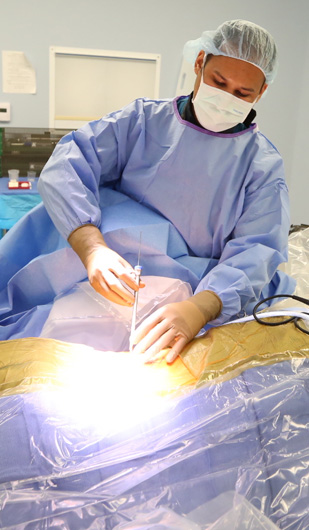
About minimally invasive equipment and techniques
All of the surgical equipment used in minimally invasive spine surgery must be able to pass through a keyhole-sized portal. These portals are left in during the entire surgery to allow specially designed surgical tools to move freely into the patient’s spinal column and not to damage the soft tissue from exiting and inserting equipment.
When the portal is removed at the end of the surgery, the surrounding soft tissues slowly fall back into their normal place and only require a small amount of stitches to close the area.
Some surgical procedures of MIS of the thoracic spine may require the anesthesiologist to specifically deflate the lung closest to the operating area and the patient will breathe with the other lung throughout the entire procedure. It is considered a very common practice in order to allow more space for the spine surgeon to operate within the thoracic spine.
Benefits of minimally invasive spine surgery include:
- Smaller incision and smaller scar
- Less damage to tissues and muscles
- Less blood loss
- Less post-operative pain
- Less painful recovery
- Quicker return to activity
Commonly asked questions about MIS
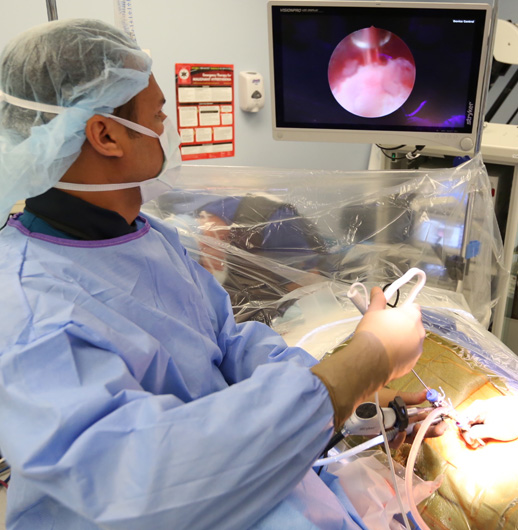
What is involved with a minimally invasive procedure?
Minimally invasive spine surgery uses a small hole the size of a dime to allow a special endoscope with a constant video feed inserted in the hole to access the damaged area of the spine.
What is a Minimally Invasive Tubular Rectractor?
A minimally invasive tubular retractor (MITR) is used to gain access to the spinal column. The device goes through a small keyhole in the muscles of the back, reducing damage to the spine where as normal open back surgery pulls the muscles away from the spine causing soft tissue damage. This device also helps control blood loss since it is not as harsh on the body than the alternative procedure.
What is a fluoroscopy?

A fluoroscopic C-arm is used to show continuous x-ray images on a monitor which enables the surgeon to navigate to precise areas in the back or neck.
Can all spine problems be treated using a minimally invasive approach?
Minimally invasive spine surgery cannot be used for all surgeries. Some procedures, like scoliosis surgery or reconstructive scoliosis surgery, require a very long incision to be able to insert special parts to be attached to the spine.
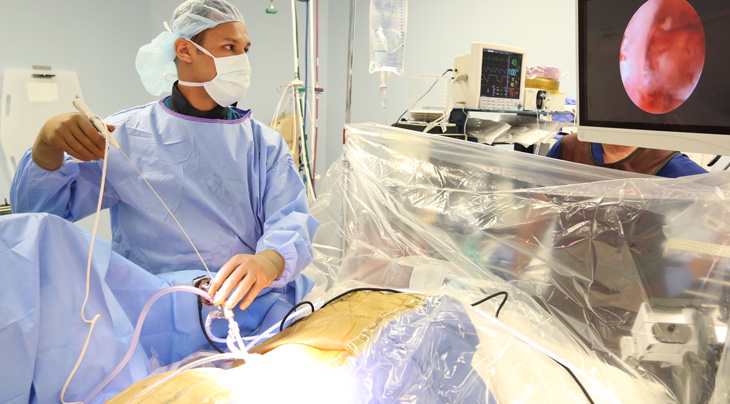
How do I know if minimally invasive surgery is right for me?
Not every spinal procedure or patient is a candidate for minimally invasive spine surgery. Your spine surgeon can advise you if there are new techniques and instrumentation available for your particular problem. Also getting a second opinion for spine surgery can help ensure that you are receiving the least invasive surgical option.
Are there risks involved with minimally invasive surgery?
Typically minimally invasive spine approaches lessen blood loss and reduce risks. Some of the risks associated with ANY type of spine surgery includes: adverse reactions to the anesthetic, blood loss, infection, blood clots, pneumonia, instrumentation tools causing damage to spine and surrounding tissues, and even paralysis (extremely rare).
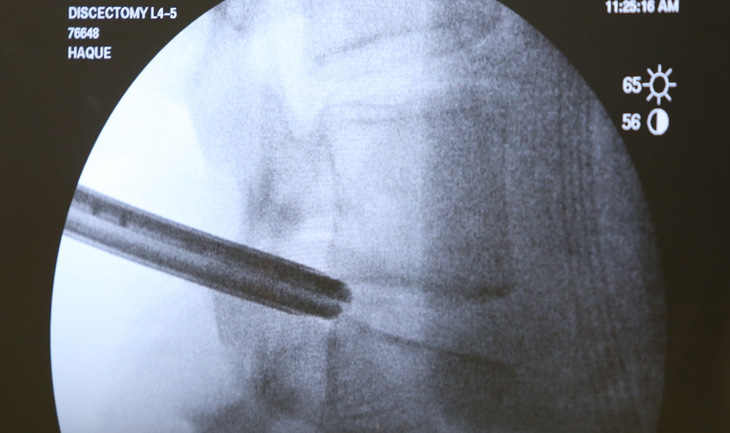
Are there steps a patient can take to reduce the risk involved of any spine surgery, including minimally invasive surgery?
If the patient has exhausted all non-surgical options and decides on a minimally invasive spine surgery procedure, it is important for the patient to stop smoking, stop taking non-essential medications that could cause an adverse reaction during surgery, and exercise regularly to increase your body’s immune system to help speed up recovery time. Make sure to ask your spine surgeon any questions or concerns that you may have.
Maahir Haque, MD is recognized as a leader in the field of minimally invasive spine surgery. At Spine Group Orlando, Dr. Maahir Haque also provides second opinions for spine surgery and MRI reviews for those with back pain and neck pain. Dr. Haque emphasizes non-surgical options for back pain and neck pain where possible. This can include accessing a back pain specialist with expertise in pain-relieving spinal injections and spine therapists. Spine therapy can include back stretches that can be a future home remedy for back pain or neck pain. If spine surgery is necessary because of a herniated disc, spinal fracture, or spinal stenosis, Dr. Maahir Haque operates through tubular retractors that reduce the size of the incision, lessen blood loss, reduce time in the hospital, speed return to activity with a less painful recovery. This spine surgery expertise enables many patients to have outpatient spine surgery and be home the same day. Spine Group Orlando and Dr. Maahir Haque provides artificial disc replacement in the neck using the Mobi-C disc implant, the first FDA-approved disc for multiple levels in the neck. Prodisc-C is also used for artificial disc replacement in the cervical spine. Dr. Haque is also one of the few spine surgeons in Orlando, Florida to provide lumbar artificial disc replacement using the Prodisc-L artificial disc. Dr. Haque is also referred patients from across Orlando and north central Florida for artificial disc replacement surgery as an alternative to spinal fusion. Accordingly, Dr. Haque's patients travel from across north central Florida, including: Orlando; Jacksonville; Tallahassee; Lakeland; Gainesville; Tampa; Daytona Beach; and Cocoa Beach. The spine center, as a destination for medical tourism for some international patients from Mexico and the Caribbean, can provide recommendations to out-of-town patients on nearby hotels and tourist attractions. Dr. Haque is featured on the national site CentersforArtificialDisc.com as an author on the subject of artificial disc replacement for herniated discs in the neck. The Centers for Artificial Disc web site has content specific to disc replacement options and alternatives to spinal fusion. Click here to visit the Centers for Artificial Disc.

